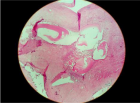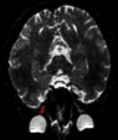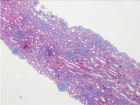Previous Issue (Volume - 8 | Issue - 2)
Renal Lymphangiectasia: A Diagnostic and Therapeutic Challenge
Published on: 10th May, 2024
Renal lymphangiectasia, a rare lymphatic disorder, manifests as cystic infiltration in the perirenal and para-pyelic space due to lymphatic drainage defects. Diagnosis hinges on imaging modalities like ultrasound, CT, and MRI. However, lack of awareness can lead to confusion with other renal cystic pathologies. Here, we present a case of renal lymphangiectasia in a child, detailing diagnostic and therapeutic strategies. The patient, a 2-year-old and 2-month-old girl from a consanguineous marriage, presented with persistent abdominal distension. Clinical examination revealed growth retardation and normal blood pressure but abdominal distension with dullness. Lab investigations indicated acute renal failure with non-nephrotic proteinuria. Radiologically, renal lymphangiectasia was confirmed by ultrasound showing microcysts and perirenal cystic lesions with ascites, corroborated by MRI and CT scans. Treatment involved nephroprotective therapy and diuretics for ascites. Surgical intervention was necessitated due to cyst size and compressive nature, involving iterative punctures, marsupialization, and percutaneous drainage. Postoperatively, recurrent ascites temporarily worsened renal function but returned to baseline afterward. renal lymphangiectasia necessitates careful management due to its potential to progress to chronic renal failure. The prognosis depends on factors like initial proteinuria severity, treatment response, and complication management. Personalized approaches are pivotal in its diagnosis and management.
Elimination of Medium/High Molecular Weight Solutes. Comparison of High Flow Hemodialysis with Extended Hemodialysis
Published on: 13th May, 2024
Introduction: Post-dilution online hemodiafiltration is the most efficient extracorporeal depurative treatment of CKD. Recently a new type of membrane has been developed, with a higher cut-off point also called a medium cut-off point, which has the capacity to eliminate higher molecular weight molecules in hemodialysis. The hemodialysis performed with these membranes has been called “Expanded Hemodialysis”.Objective: Compare the purifying efficacy of medium and high molecular weight molecules in patients dialyzed with high-flux hemodialysis, VitaPES 210HF, and with patients treated with expanded hemodialysis with the medium cut-off dialyzer, Elisio-HX.We also assessed the effect that the increased removal of inflammatory mediators by MCO hemodialysis had on fecal Calprotectin levels.Patients and methods: This is a prospective observational cross-over study in which 8 prevalent hemodialysis patients were followed for two months. Blood levels of IL-6, C-reactive protein (CRP), β2-microglobulin, Kappa and Lambda immunoglobulin light chains, and serum albumin were determined before and after each hemodialysis session.Results: The percentage of reduction of medium and higher molecular weight molecules: β2microglobulin, IL-6, Kappa and Lambda chains and CRP were higher with the Elisio-21HX dialyzer compared to the VitaPES 210HF dialyzer. There was no difference in albumin clearance between the two dialyzers.Fecal calprotectin levels were lower in patients dialyzed with Elisio-21HX.Conclusion: The medium cutoff dialyzer, Elisio-HX, is more efficient in the elimination of medium/high molecular weight molecules than the VitaPES HF high-flux dialyzer, with the same albumin elimination.Improving inflammation at the local intestinal level with lower levels of fecal Calprotectin.
Renal Adverse Reaction Secondary to Check-point Inhibitors in Metastatic Renal Cancer
Published on: 17th May, 2024
Immune Checkpoint Inhibitors (PCIs,) are monoclonal antibodies directed against immune checkpoint regulatory molecules. These antibodies inhibit T-cell activation and prolong survival in patients with different types of cancer. However, they can produce adverse effects related to the immune response such as renal damage.We present the clinical case of a 75-year-old man with a personal history of Chronic Kidney Disease (CKD) and metastatic renal cancer with lung, bone, and mediastinal involvement. He started treatment with immunotherapy with Nivolumab-Ipilimumab. Then, after 4 cycles of immunotherapy, the patient was admitted to the Urology Department for an adverse reaction to immunotherapy with the development of nephritis and toxic hepatitis. Despite treatment with methylprednisolone, he evolved poorly, and a palliative approach was finally decided.The incidence of acute renal failure attributed to PCIs is estimated at 2% - 3%, being grade I-II in most cases. Among the renal complications associated with PCIs, acute interstitial nephritis is the most predominant with an incidence of 80% - 90% of cases. In addition, an increased risk is observed in patients with intermediate or poor risk metastatic renal cancer.Despite their fundamental role in metastatic renal cancer, we must take into account the potential for renal failure as an adverse effect of PCIs, especially in patients with previous CKD.
Neurocognitive and Adaptive Functioning in Young Patients with Severe Chronic Kidney Disease
Published on: 11th June, 2024
Background: To assess the association between neurocognitive functioning, adaptive functioning, and health-related quality of life (HRQoL), in Children and Young Adults with Severe Chronic Kidney Disease (CKD).Methods: We included patients with severe CKD (stages 4 and 5), aged 8-30 years, on different therapy modalities (pre-dialysis, dialysis, and transplanted) and healthy controls matched on age, sex, and parental education. All patients and healthy controls performed tasks to assess neurocognitive functioning (WISC/WAIS and a comprehensive neuropsychological test battery), and completed questionnaires to assess adaptive functioning (WFIRS or WHODAS) and HRQoL (PedsQL). Group differences were explored using MANCOVA. Mediation analyses were done to explore whether the relation between neurocognitive functioning and HRQoL was mediated by adaptive functioning. Results: 28 patients with severe CKD and 21 healthy matched controls were included. CKD patients had worse HRQoL (p < .001) than healthy controls. Adaptive functioning problems increased with age in the CKD patient group but not in the healthy control group (significant interaction effect: p = .024). Significant mediation effects were found, where impaired adaptive functioning mediated the relation between both low estimated Full Scale Intelligence Quotient (eFSIQ) and worse Processing Speed & Working Memory, and impaired HRQoL (eFSIQ: 95% confidence interval = .01-.58; Processing Speed & Working Memory: 95% confidence interval = 2.31-16.36).Conclusion: We found that impaired neurocognitive functioning is associated with worse HRQoL, which is conditional to impaired adaptive functioning. Especially towards young adulthood problems in adaptive functioning are more likely to be reported than when patients are younger.
Bridging the Gap: Challenges and Solutions in Online Nephrology Education
Published on: 11th June, 2024
The outbreak of COVID-19 has created an unprecedented situation that has accelerated online education in areas like nephrology, which are traditionally served by onsite training. Efforts to educate clinicians remotely provide convenience and flexibility but may leave many open questions when it comes to how well-trained professionals maybe after completing their programs online. This review paper has emphasized the deleterious effects of online nephrology education and identified a number of ways in which it can be problematic such as lack of hands-on training, less patient interface, lack of proper supervision, and inconsistent quality of programs. The ability to make a difference, however, is further restricted by technological barriers and resource constraints. Whilst these programs tend to focus on creating knowledgeable graduates, they often fail to provide the clinical exposure necessary for preparedness. Hybrid programs - which combine online courses with clinical training in person are required to deliver high-quality nephrology care.
Obstetric Renal Failure: Causes, Prognosis, and Evolution
Published on: 8th August, 2024
The incidence of obstetric acute renal failure remains significant in developing countries. The aim of our study is to define the risk factors involved in the occurrence of ARF during pregnancy or during the immediate postpartum period and to evaluate its evolutionary profile in terms of epidemiology, etiopathogenesis, and therapeutic management over the years in Morocco. This is a retrospective study conducted in the maternal-infant resuscitation service of the Ibn Rochd University Hospital of Casablanca, over the period from January 2020 to August 2023, including 95 patients. The current incidence in our series over this period was 22.2%. The mean age of our population was 33 ± 7.74 years [18-43 years], 67.3% of patients were in the gestational period, compared to 33.7% in the immediate postpartum period. Fourteen patients were primiparous (8.6%), 27.4% had a history of miscarriage, and 10.7% had a history of pre-eclampsia. Oligo-anuria was initially identified in 24 patients. The most frequent etiology was pre-eclampsia (56.7%), followed by hemorrhage (27%) and sepsis (19.3%). The evolution was marked by recourse to hemodialysis in 62% of cases, with a maternal mortality of 26%. The existence of heart disease, the context of pre-eclampsia, and the use of diuretics and vasoactive drugs were significantly correlated with maternal survival. No factor was correlated with secondary recovery from ARF. The development of health structures and the optimization of screening strategies are the keywords for prevention.
Seminal Extracellular Traps in SARS-CoV-2 Infection
Published on: 19th August, 2024
Introduction: Extracellular Traps (ETs) are fibers composed of chromatin and cytoplasmic proteins, which can trap and kill pathogens by the phenomenon called ETosis. They are released by neutrophils, macrophages, and monocytes, and can be found in semen. The aim of this presentation is to evidence of the indirect effect of SARS-CoV-2 in semen by ETs.Patients and methods: Experimental design: retrospective descriptive observational study.Semen samples from two groups were studied following WHO guidelines: 1) SARS-CoV-2 infected donors (n: 5; at 7, 15, 30, 60, and 90 days after PCR diagnosis); 2) COVID-19 positive patients assisted in our laboratory between 2021 and 2022 (n: 70). They were observed in fresh and in Papanicolaou-stained smears by CASA and light microscopy; the presence of macrophages, spermiophages, ETs and hyperviscosity were recorded while neutrophilic concentration was calculated. Two control groups were designed: a) Patients belonging to group 2, studied before de pandemia (n: 13); b) Culture-negative semen samples (n: 28).Results: In the first group, ETs were observed in all the samples, while only 18% had leucospermia. Macrophages, spermiophages, and hyperviscosity were recorded in 68%, 27%, and 36% of the studied cases respectively.In the second group, ETs were present 100% in the acute phase (< 90 days after diagnosis) and decreased to 71% in the later stage (90 to 270 days). The trapped sperm were non-progressive motile or immotile alive or dead.No traps were found in either control group.Conclusion: In our study ETs were the most sensitive seminal marker of SARS-CoV-2 infection.
A Case of Good Efficacy of Tolvaptan in a Patient with Markedly Enlarged Polycystic Kidney
Published on: 20th August, 2024
A 61-year-old patient with autosomal dominant polycystic kidney disease (Irazabal class 1E) in whom renal function had decreased and kidney size had increased over the past 3 years (change in serum creatinine, 1.3 mg/dL to 1.5 mg/dL; change in total kidney volume, 5632 cm3 to 7301 cm3) was treated with tolvaptan 60 mg/day. After 8 years of tolvaptan treatment, serum creatinine remained at 1.51 mg/dL, and total kidney volume was at 6812 cm3. Adequate salt intake and good weight control may have resulted in good outcomes, even in patients with treatment-resistant giant cystic kidney disease.
Prevalence of Cognitive Impairment in Dialysis Patients in Gauteng Province, South Africa
Published on: 26th August, 2024
Introduction: Cognitive impairment is defined as a new deficit in at least two areas of cognitive functioning. These may include disturbances in memory, executive functioning, attention or speed of information processing, perceptual motor abilities, or language. It has been shown that cognitive impairment is associated with the severity of kidney disease. Methods: The study was a descriptive research design, with participants purposively sampled from the general chronic kidney disease population which included haemodialysis and peritoneal dialysis patients at Steve Biko Academic Hospital in Pretoria, Gauteng Province, South Africa. Hundred and fifty-one participants (76 hemodialysis & 75 peritoneal dialysis patients), 58% were males, and 42% were females aged 19-61 years. To establish the prevalence of cognitive impairment by testing the level of cognition the Mini-Mental State Examination was utilized to provide a brief screening test to quantitatively assess the cognitive abilities and cognitive changes of patients while on dialysis. Results: Ninety-nine percent (99%) of the recruited population reported no cognitive impairment, irrespective of dialysis modality, demographic characteristics, and socio-economic status. Conclusion: Despite the findings highlighting that the majority of the chronic kidney disease population at Steve Biko Academic Hospital reported no cognitive impairment, it is crucial to increase awareness of the potential effects of cognitive impairment on daily activities, quality of life, and treatment adherence. Early detection and management of cognitive impairment can significantly impact the quality of life and adherence to treatment among these patients. Further research is needed to understand the prevalence and impact of cognitive impairment in different populations and to develop effective interventions for its prevention and management.
An Overview of Familial Hypocalciuric Hypercalcemia
Published on: 26th August, 2024
Familial hypocalciuric hypercalcemia (FHH) is one of the rare reasons for hypercalcemia. FHH is an autosomal dominant disease that is inheritable. The most common calcium sensitive receptors (CaSR) develop because of the inactivation of. In addition, they also develop due to the function loss of AP2S1 and GNA11. The FHH sickness is characterized by hypercalcemia, hypocalciuria, the regular or increased level of the parathyroid hormone, and normal renal function. The symptoms of hypercalcemia are usually not observed. It is often diagnosed by calculating the calcium/creatine clearance ratio of a 24-hour urine sample, and then genetically looking at it. FHH is usually a benign disorder, and when symptomatic and rarely complications develop, calcimimetics are used or parathyroidectomy can be performed. In conclusion, FHH is a benign and genetically transmitted, moderate cause of hypercalcemia. It is rare and usually asymptomatic.
An Uncommon Case Report of Hypothyroidism, Type 1 Diabetes Mellitus, and Systemic Lupus Erythematosus with an Immunosuppressive Consequence: A Case Report
Published on: 27th August, 2024
An autoimmune condition known as Systemic Lupus Erythematosus (SLE) affects several systems and manifests itself in a variety of ways. It is far more common among young women who are fertile.It has been demonstrated that a mix of environmental and genetic variables may trigger immunological responses, triggering T and B cells, and leading the B cells to overproduce pathogenic autoantibodies and dysregulate cytokines, which ultimately result in harm to many organs and tissues. One feature of SLE is the presence of antibodies against cytoplasmic and nuclear antigens. An autoimmune illness is also type 1 diabetes. β-cell antibodies (Ab) and other antibodies that cause the autoimmune death of the pancreatic β-cells, which make insulin, are part of the multifactorial pathophysiology of type 1 diabetes mellitus (T1DM).Immunosuppression is the therapy for systemic lupus erythematosus (SLE), and diabetes itself compromises immunity, making infections more opportunistic. We came across an unusual instance of a patient with SLE, T1DM, hypothyroidism on immunosuppression who subsequently acquired pulmonary TB.Key phrase: Autoimmune diseases such as type 1 diabetes mellitus (T1DM) and Systemic Lupus Erythematosus (SLE).

HSPI: We're glad you're here. Please click "create a new Query" if you are a new visitor to our website and need further information from us.
If you are already a member of our network and need to keep track of any developments regarding a question you have already submitted, click "take me to my Query."



























































































































































